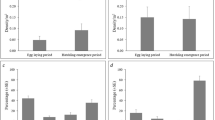Synopsis
Predation on large, energy rich eggs is common in terrestrial and freshwater communities with the eggs of amphibians, reptiles and birds figuring as prominant prey. We might predict that predation on large eggs would also be widespread in marine communities. However, little information is available to test this prediction. We present new evidence for such predation on elasmobranch eggs based on examination of capsules held in museum collections, those collected from beaches, long-term incubations of caged egg capsules, and SCUBA observation. The principal egg predators appear to be gastropods, though vertebrates contribute to mortality of embryonic elasmobranchs. As yet we can only speculate about the effects of egg predation for populations of oviparous elasmobranchs, or about the direct and indirect consequences predation upon their energy-rich eggs may have for marine communities.
Similar content being viewed by others
References cited
Carriker, M.R. & E.L. Yochelson. 1968. Recent gastropod boreholes and Ordovician cylindrical borings. Contributions to Paleontology, Geological Survey Professional Paper 593-B, U.S. Government Printing Office, Washington. 26 pp.
Clark, R.S. 1922. Rays and skates (Raiae). I. Egg-capsules and young. J. Mar. Biol. Assoc. U.K. 12: 577–643.
Darwin, C. 1859. On the origin of species by means of natural selection, or the preservation of favoured races in the struggle for life. John Murray, London. 513 pp.
Grover, C.A. 1972. Predation on egg-cases of the swell shark Cephaloscyllium ventriosum. Copeia 1972: 871–872.
Jensen, A.S. 1914. The selachians of Greenland. pp. 1–40. In: H.F.E. Jungersen & E. Warming (ed.) Mindeskrift i Anledning af Hundredaaret for Japetus Steenstrups Fodsel, Vol. 2, Bianco Lunos Bogtrykkeri, Kobenhavn.
McEachran, J.D., D.F. Boesch & J.A. Musick. 1976. Food division within two sympatric species-pairs of skates (Pisces: Rajidae). Marine Biology 35: 301–317.
McLaughlin, R.H. & A.K. O"Gower. 1971. Life history and underwater studies of a heterodont shark. Ecol. Monogr. 41: 271–289.
Morejohn, G.V. & D.M. Baltz. 1970. Contents of the stomach of an elephant seal. J. Mammalogy 51: 173–174.
Nichols, J.T. 1931. Egg capsule of Scyliorhinus retifer. Copeia 1931: 38–39.
Read, L.J. 1968. Urea and trimethylamineoxide levels in elasmobranch embryos. Biol. Bull. 135: 537–547.
Smith, B.G.1942. the heterodontid sharks: their natural history, and the external development of Heterodontus japonicus based on notes and drawings by Bashford Dean. pp. 647–770+ 7 plates. In: E.W. Gudger (ed.) Bashford Dean Memorial Volume, Archaic Fishes, American Museum of Natural History, New York.
Springer, S. 1967. Social-organization of shark populations. pp. 149–171. In: P.W. Gilbert, R.F. Mathewson & D.P. Rall. Sharks, skates, and rays. The Johns Hopkins Press, Baltimore.
Author information
Authors and Affiliations
Rights and permissions
About this article
Cite this article
Cox, D.L., Koob, T.J. Predation on elasmobranch eggs. Environ Biol Fish 38, 117–125 (1993). https://doi.org/10.1007/BF00842908
Received:
Accepted:
Issue Date:
DOI: https://doi.org/10.1007/BF00842908




